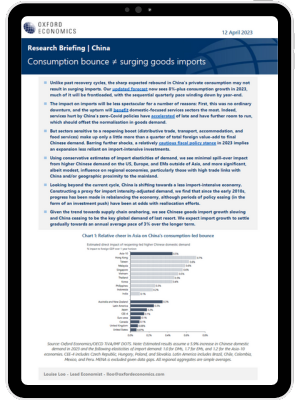China: Consumption bounce ≠ surging goods imports

Unlike past recovery cycles, the sharp expected rebound in China’s private consumption may not result in surging imports. Our updated forecast now sees 8% plus consumption growth in 2023, much of it will be frontloaded, with the sequential quarterly pace winding down by year-end.
The impact on imports will be less spectacular for a number of reasons: First, this was no ordinary downturn, and the upturn will benefit domestic-focused services sectors the most. Indeed, services hurt by China’s zero-Covid policies have accelerated of late and have further room to run, which should offset the normalisation in goods demand.
What you will learn:
- But sectors sensitive to a reopening boost (distributive trade, transport, accommodation, and food services) make up only a little more than a quarter of total foreign value-add to final Chinese demand.
- Using conservative estimates of import elasticities of demand, we see minimal spill-over impact from higher Chinese demand on the US, Europe, and EMs outside of Asia, and more significant, albeit modest, influence on regional economies, particularly those with high trade links with China and/or geographic proximity to the mainland.
- Looking beyond the current cycle, China is shifting towards a less import-intensive economy. Constructing a proxy for import intensity-adjusted demand, we find that since the early 2010s, progress has been made in rebalancing the economy, although periods of policy easing (in the form of an investment push) have been at odds with reallocation efforts.
Tags:
Related posts

Post
Tariffs 101: What are they and how do they work?
Tariffs are taxes imposed by a government on goods and services imported from other countries. Think of tariff like an extra cost added to foreign products when they enter the country. They’re usually a percentage of the price of the goods, making imported items more expensive compared to domestically produced good
Find Out More
Post
Global Scenarios Service – Heightened Tensions
This quarter’s scenarios quantify key risks to the global economy. These relate primarily to trade protectionism and other geopolitical tensions, structural weakness in the Chinese economy, the stance of monetary and fiscal policy, and financial market conditions.
Find Out More
Post
U.S. dollar strength to remain; Fed to hold interest rates until December
Innes McFee, Managing Director of Macroeconomic and Investor Services at Oxford Economics, discusses the outlook for the U.S. dollar and adds that tariffs will be a “negative” for the U.S. economy.
Find Out More